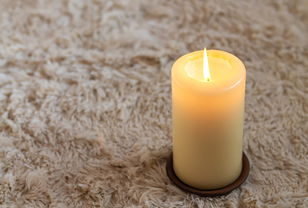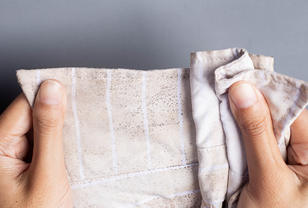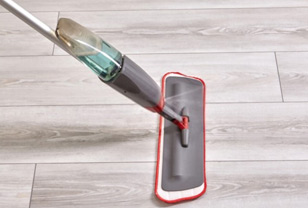Exploring the Difference between Vinyl And Laminate Flooring: A Detailed Guide
Don’t feel bad if you can’t distinguish them apart. It’s hard for even professionals to find the difference between vinyl and laminate flooring just by seeing a picture alone or without extensive, hands-on testing. These planks are made to have as close a resemblance to hardwood floors as possible, and they both do an excellent job at it!
But there are a couple of tricks that you can use to tell a vinyl plank apart from a laminated one. This guide will show you how!
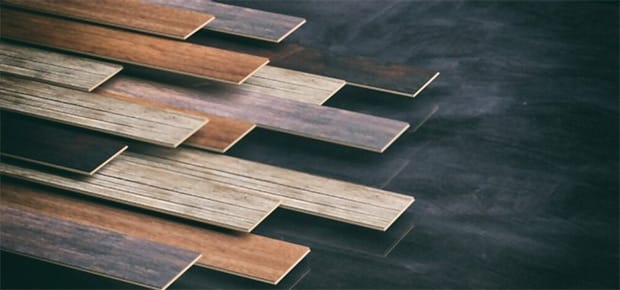
Wondering if there’s a difference between vinyl and laminate? Here’s the guide for you!
What Are Vinyl and Laminate Floorings?
Vinyl Flooring
Attractive, versatile, durable, and affordable — it’s not surprising that vinyl floorings have become so popular!
It’s been around for literal centuries, dating back to 1872. But it wasn’t mass-produced and marketed to the wider public until the 1930s.
During most of the 20th century, the only vinyl tiles available were Vinyl Composite Tiles (VCT) and sheet vinyl. They’re still around today, but since the 70s, other kinds of vinyl floor planks have arrived at the market.
For example, on the catalogs of flooring manufacturers, you’ll also find Luxury Vinyl Tiles (LVT) and Luxury Vinyl Planks (LVP). Although they’re pricier (hence the “luxury” tag), they’re thicker and made from more durable materials compared to old VCT and sheet vinyl.
But whatever type you choose, vinyl flooring is known for its durability. That makes it a great choice for areas that are likely to see high traffic levels, like the living room or the kitchen.
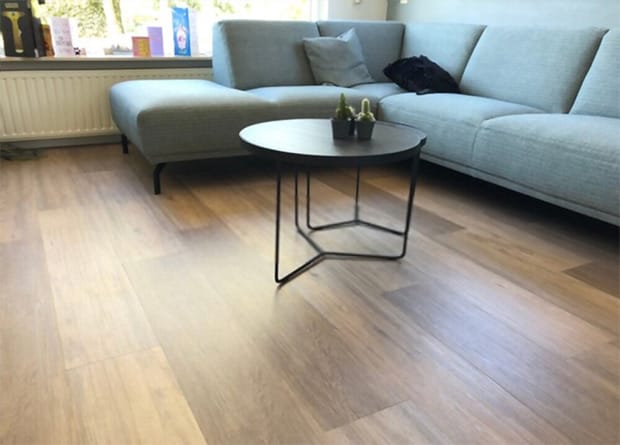
Vinyl is extremely popular for high-traffic areas like the living room
It can be found in various colors and patterns, allowing homeowners to customize a living space according to their personal aesthetic. The multiple designs available can be further enhanced with mixed borders, accents, and inlays.
Vinyl flooring is also super environmentally friendly. The planks can be built over existing surfaces in the house, reducing waste.
And if you care about costs … vinyl flooring is also a superb choice in this respect, especially when compared to other hard surface flooring options, such as hardwood.
Laminate Flooring
Laminate flooring is one of the most popular options on the flooring market today.
History-wise, it’s a “newer” type of floor compared to vinyl. It was officially introduced to the European market in 1984 and the North American market in the 90s.
Each plank is created from sheets of fiberboard that are pressed together with an embossed, wood-like design on top. The embossed design gives laminate flooring the look and feel of real hardwood but for much less money.
But laminate flooring’s secret weapon is the protective coating at the top, called the “Lamination.”
It is a transparent, bonded layer that protects the floor from everyday wear and tear. This layer also prevents staining and makes cleaning and maintaining the floor easier.
The thicker and sturdier the lamination, the more expensive the laminate flooring. But consider it as a long-term investment: the thicker lamination will be able to withstand more damage before needing to be replaced.
Laminate flooring is easy to install and maintain. It can be installed over most existing floors, including concrete and vinyl, provided that the subfloor is level and there are no defects in the existing floor.
But the key aspect that has made laminate floorings so popular is that they’re incredibly low-maintenance.
Sweep and vacuum it regularly, mop it with a damp mop and a cleaner made specifically for laminate flooring, and that’s about all you need to do to keep your laminate floors looking great!
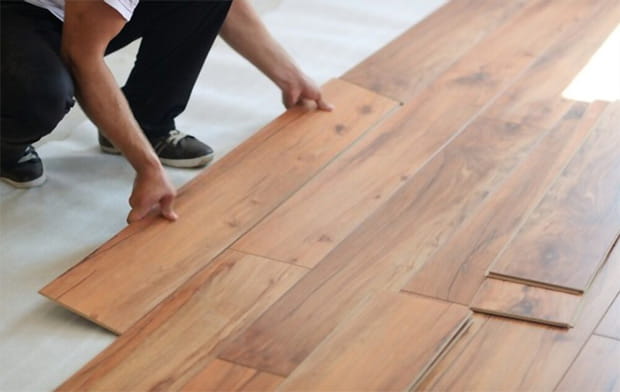
Laminate flooring is popular for its ease of maintenance
➜ RELATED: Best Steam Mop for Vinyl Floors: Buying Guide & Best Product Reviews
What Are the Differences Between Vinyl and Laminate Floorings?
Though they may look alike, there are actually many differences between these two types of flooring. Here are the differences between them as well as vinyl vs laminate flooring pros and cons.
Construction
This is the primary difference between vinyl and laminate flooring: their construction.
Vinyl flooring comprises several layers of plastic materials, creating a waterproof and resilient surface.
The top layer is a vinyl print layer, which gives the flooring a realistic look and feel. It’s protected by a durable topcoat (called the “wear layer”) to protect this fragile print layer from scratches, damages, and liquid stains.
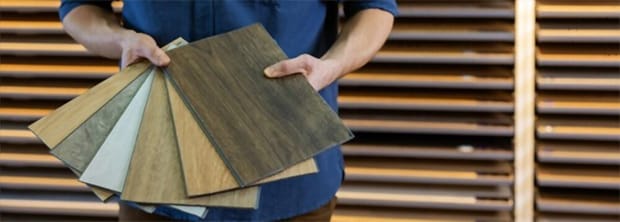
The top layer protects the beautiful print underneath from damages
Underneath the vinyl is a solid core commonly reinforced with fiberglass for added strength and to help with installation.
The bottom layers (called the “underlayments”) are usually made from plywood. It acts as a cushioning material and stabilizes the plank in place. The underlayment also reduces noise, so there are no creaking or hollow, thudding sounds while you’re walking around on it.
Laminate flooring comprises several layers of fiberboard, fiberglass, and resin. The top layer is a print film layer, which gives the floor the desirable, beautiful look comparable to real, natural materials like hardwood. The print film is very fragile and can be scratched off easily. That’s why it has to be protected by a thick lamination. Without it, the floor plank will look terrible within days of installation.
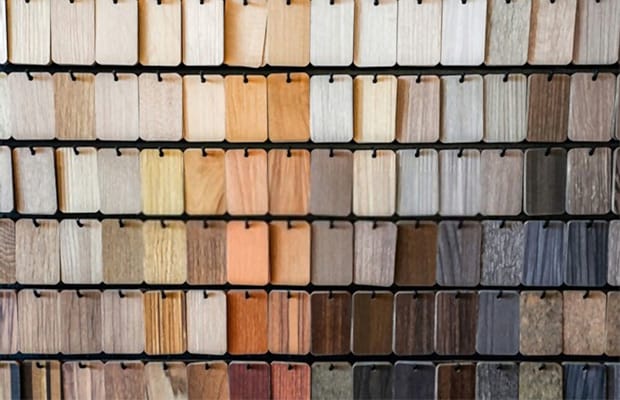
The bottom layers usually cushion and stabilize the planks to give the floor more strength and prevent warping in extreme temperatures.
Cost
Laminate flooring is typically less expensive than vinyl flooring. It’s considered the most affordable alternative to natural hardwood floors. If you want to cover your floor in laminate, it only costs an average of $2 to $5 per square foot.
That’s all thanks to the magic of modern printing technology. Industrial printers these days can recreate the patterning of natural materials such as wood or stone in great detail but at very cheap costs.
Vinyl flooring, on the other hand, usually costs between $3 to $7 per square foot. Other than the construction and type of plank, manufacturers also price their vinyl floorings by design. Vinyl planks or tiles with more intriguing and complex patterns and colors will usually be more expensive.
Comfort and Noise
Although the floor manufacturers try hard to make laminate and vinyl planks look and feel exactly like natural hardwood, they aren’t quite there yet. Natural hardwood is warm on the feet and quiet to walk on.
Both laminate and vinyl aren’t so. On both types of floorings, you’ll hear the sound of people walking around (especially if they wear heels or heavy shoes).
However, laminate floors are warmer to walk on. And with a good layer of underlayment (made from foam or felt), the noise can be dampened significantly.
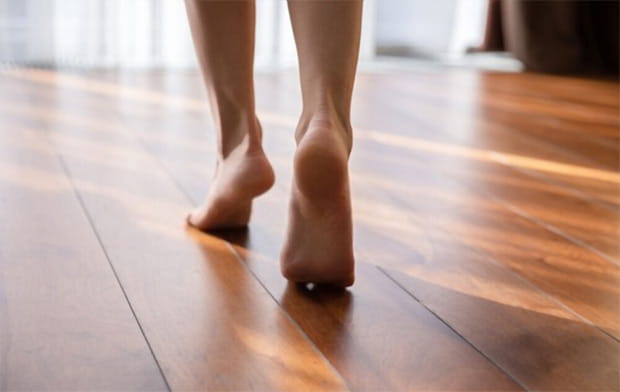
Vinyl feels cold and hard on the feet. This is especially true for vinyl planks installed on concrete or ceramic tile floors. But in return for their uncomfortable feel, vinyl floors are quiet to walk on.
Installation Style
Laminate flooring is typically installed using a click-and-lock system, where the pieces snap together to form a water-resistant flooring surface. This is the only installation style that you can use for laminate floorings.
Vinyl flooring can also be installed using the click-and-lock system. But you have a lot more options than that. You can choose the glue-down method, peel-and-stick method, or loose-lay method, depending on your budget and needs.
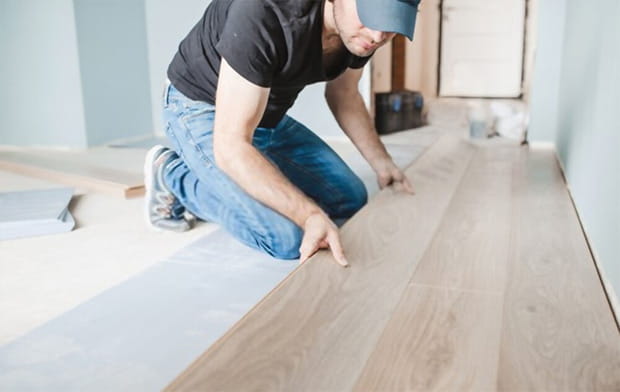
Maintenance
This is one of the chief differences between laminate and vinyl.
When it comes to the subject of maintenance, vinyl flooring is the easier of the two to care for.
Spills and dirt can be cleaned easily with a broom, mop, and water, making it appropriate for both indoor and outdoor use. This is all thanks to the top waterproofing layer that it has. You don’t have to worry when you need to apply moisture to vinyl, unlike laminate.
On the other hand, laminate flooring will require a lot more regular and careful maintenance.
Due to the way it’s constructed, laminate flooring is more susceptible to heat and can expand and contract in response, leading to warping.
The surface of a laminate is also more easily damaged by water. If the liquid spill is left for too long on the floor, it may turn into a water or liquid stain. And once the stain has settled in, you won’t be able to scrub it off. Your only option then would be to change out the planks entirely!
So, all in all, vinyl is the better choice when it comes to maintenance. Laminate sure has the cost advantage and the beautiful look of natural hardwood, but it will require more careful and frequent maintenance. This may be a dealbreaker for some people.
Waterproof Ability
Vinyl flooring generally has better waterproofing abilities than laminate flooring.
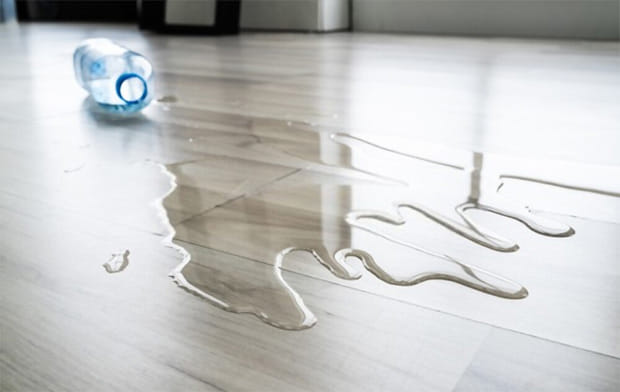
This is why architects tend to use it to cover the floor of areas prone to spills or humidity, such as the bathroom or the areas near faucets and sinks in the kitchen.
The most recent types of vinyl floors, such as Stone Polymer Composite (SPC) and Wood Polymer Composite (WPC) planks, are 100% waterproof. You can spill liquids on them all day without worrying about liquid stains or water damage (but it’s still better to sweep up liquids on the floor as soon as they’re spilled on the floor.)
Most laminate flooring has a water-resistant coating and will resist spills, but it can eventually be damaged by standing water or long-term moisture exposure. Prolonged exposure to moisture can subsequently cause warping or swelling. And if the humidity level in your house is too low, the planks can shrink and cause unsightly gaps on your floor.
Surface Texturing
The most notable physical difference between vinyl and laminate flooring is the surface texture of each kind of plank.
Laminate floors tend to have a very smooth and flat surface, not unlike natural hardwood. This is why, despite being much less durable than vinyl, many people still prefer to use laminate for their homes.
On the other hand, vinyl floors have a slightly rough, textured surface that can feel pretty artificial.

Try laminating if your floor looks and feels as close as possible to natural hardwood. Install them in areas like bedrooms where there usually isn't a lot of traffic to wear down the lamination prematurely.
On the other hand, vinyl is a great stand-in for kitchens and bathrooms where there are a lot of spills. Sure, they may look and feel less organic, but it’s far better than having to deal with scuffed-up and stained laminate flooring!
Eco-friendliness
If you care about the environment, then vinyl flooring will have the upper hand in this debate.
Vinyl flooring is more eco-friendly than laminate flooring. It is typically made of recycled materials or products that contain fewer toxins. Laminate flooring is usually made of a composite material that may contain formaldehyde, an irritant to both humans and animals.
Additionally, vinyl flooring can be recycled and is easier to maintain than laminate flooring. You can clean vinyl flooring with plain water or nature-based cleaners like vinegar. Meanwhile, to best clean laminate, you’ll most likely need to enlist the help of chemical-based cleaning solutions.
Resale Value
If you’re playing the long game and are planning to maintain your house’s value for when you eventually sell it off, the type of floor you pick will greatly impact its value.
Between laminate and vinyl flooring, there are several factors that you need to take into account.
Because of the lower price point of laminate, it most likely won’t affect your house’s resale value by much (positively, at least.) That being said, laminate can still add some value to your home if you manage to keep it looking pristine by the time you sell the house and you use high-quality laminate floorboards.
On the other hand, vinyl can add a lot of value to your home when you resell it. This is mostly because the design of vinyl floors is so fluid: you can use it to recreate the organic, rustic feel of natural hardwood or the sturdiness of natural stone. In other words, it can help you create a beautiful, luxurious floor that’ll improve the value of your home.
However, this will only apply if you use high-quality vinyl floors. Budget vinyl planks will most likely not increase your home's resale value by much.
Which Is the Best Between Vinyl vs. Laminate Flooring?
Now that you’ve known what is the difference between vinyl and laminate flooring let’s try another question: which is the best?
The answer, unfortunately, may disappoint you: It depends.
Now, look. As much as we’d love to give you a straight answer, the “Vinyl vs. Laminate” debate has been raging for years. Vinyl and laminate flooring have their respective pros and cons, and only you can decide which one will make a better suit for you.
Both vinyl and laminate floorings are durable, waterproof, affordable, and easy to install.
On the vinyl side of the debate, it’s more expensive than laminate upfront. However, it’s easier to install, more durable, waterproof, and comes in a variety of colors, styles, designs, and textured options. The waterproofing ability of vinyl makes it the perfect choice for bathrooms, laundry rooms, and basements — places where there is a lot of moisture and a high chance of liquid spills.
In contrast, laminate floorings are cheaper. If you’re looking for flooring that’s beautiful, many laminate floor planks can replicate the natural look of hardwood floors almost perfectly. The downsides are that they’re more fragile, prone to moisture damage, and are a bit more difficult to install than vinyl.
As you can see, there’s really no “one-size-fits-all” solution to this problem. You’re going to have to be the one to choose which one to go for, depending on your budget and your house plan.
Conclusion
That’s the complete answer to the question of what's the difference between vinyl and laminate flooring.
Overall, they’re both excellent floor types and are the more affordable alternatives to natural materials like hardwood and stone. Still, as you can see above, although they may look very similar to one another, they can’t be anymore different from one another.
We hope now that you’ve known the difference between vinyl and laminate flooring, you can better decide on what type of floor to pick for your next house renovating project!


